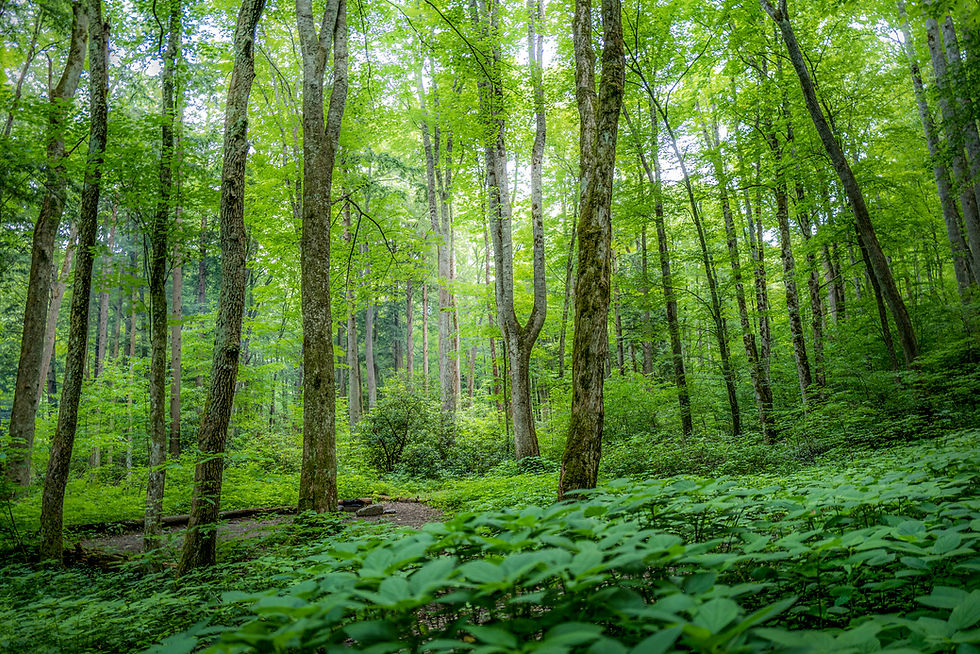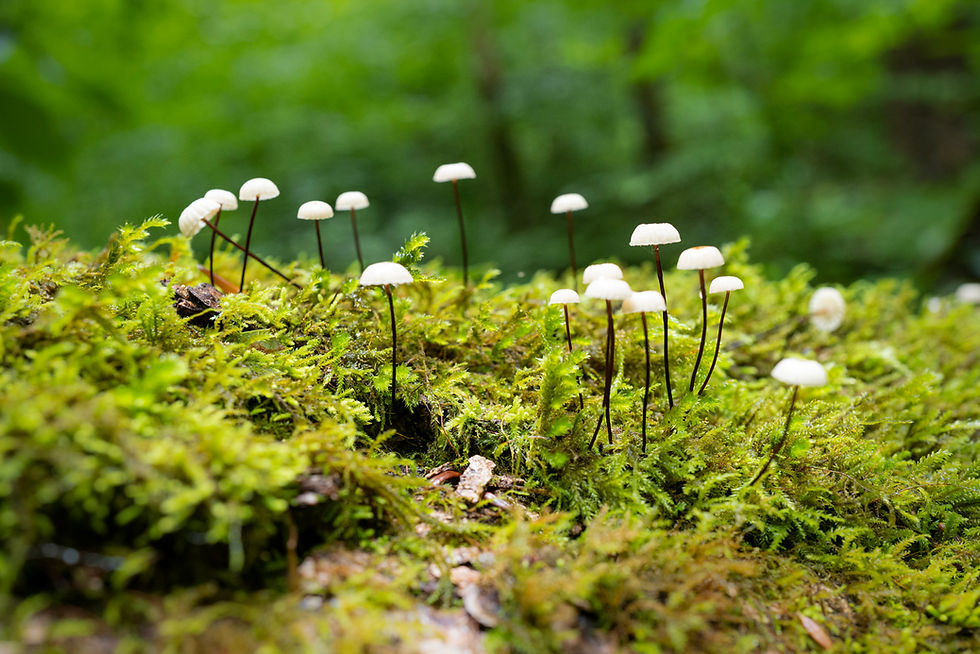Yakushima: In Mononoke Forest
- Amit Zoran
- Apr 22
- 9 min read

Yakushima contains one of the most distinctive temperate forests on Earth, where ancient Cryptomeria trees—some over two thousand years old—anchor an ecosystem of exceptional continuity. These forests hold deep cultural and spiritual significance in Japan, shaped by centuries of reverence and myth. Their role as a living interface between biodiversity, time, and belief matches their ecological value. Nowhere else in the temperate world do such climatic and geological conditions combine to sustain a forest of this age, density, and ecological integrity.
Yakushima is a mountainous, circular island located south of Kyushu, forming part of the Ōsumi archipelago. Characterized by steep terrain, it includes Mount Miyanoura-dake, the highest peak in Kyushu at 1,936 meters.
The island receives extraordinary levels of rainfall—ranging from around 4,000 mm annually in its coastal zones to over 10,000 mm in its mountainous interior. These figures make Yakushima one of the wettest temperate regions on Earth, receiving significantly more rain than the central Amazon and receiving rainfall that rivals or exceeds that of many tropical rainforest regions.
The high rainfall, constant humidity, mild temperatures, and nutrient-poor soils create ecological conditions that encourage exceptionally slow tree growth and extended lifespans. These unique factors contribute to the island’s globally significant biodiversity and earned it UNESCO Natural World Heritage status in 1993.
Vertical Ecology
I visited Yakushima in early spring and encountered one of the island’s most striking visual qualities: the quiet unfolding of its forest canopy. Yakushima’s forests undergo marked seasonal transformations, particularly in spring, when the entire island displays a nuanced tapestry of greens. While seasonal forest changes are a global phenomenon, Yakushima is unique in preserving a continuous vertical gradient of transformation—from sea level to mountaintop—within a relatively compact area.
In contrast to deciduous forests, where spring brings a stark transition from bare branches to uniform green, or tropical jungles with less pronounced seasonal variation, Yakushima’s vegetation undergoes a layered, gradual shift. What emerges is a dense mosaic of greens—ranging from pale yellow-greens to deep, saturated shades—spread across species, altitude, and light conditions.
This emergence is not dramatic but immersive, offering a quiet, bodily sense of renewal. The change is registered not only in light and atmosphere, but in the foliage itself. While such gradations exist in other mountainous forests, Yakushima offers an unusually coherent experience: driving the narrow road that encircles the island, one sees entire mountains—rising straight from the sea to their misted peaks—blanketed in uninterrupted green, free from visible human intrusion. This continuity, both spatial and chromatic, is exceptionally rare.

Subtle Shifts Within a Continuity of Green
This visual continuity is not only a matter of scale, but of composition. Among the island’s dominant broadleaf species, camphor trees (kusunoki, クスノキ, Cinnamomum camphora) are among those that contribute most visibly to Yakushima’s spring transformation. Their foliage shifts from dark green to luminous lime as new leaves emerge—a renewal process echoed by other evergreens across the island.
Oaks such as akagashi (アカガシ, Quercus acuta), castanopsis (tsurubami, ツルバミ, Castanopsis sieboldii), and tabunoki (Machilus thunbergii) each add their own variation to the unfolding palette. This synchronized regeneration across multiple species and elevations produces a richly textured interplay of young and mature greens. Amplified by the island’s persistent humidity and rainfall, the result is not dramatic but continuous—an ongoing modulation of tone and density that quietly defines the forest’s presence.
Even the conifers, which do not renew their foliage in spring, add to the chromatic composition. The ancient yakusugi (屋久杉) and other Cryptomeria japonica present deep, cool-toned greens—often with a bluish or silvery cast—that anchor the lighter hues around them. Their stable coloration creates visual contrast and depth, reinforcing the layered structure of the forest.
Mosses further enrich this landscape, particularly in the island’s higher elevations and persistently humid zones. In areas such as the Shiratani Unsuikyo ravine, mosses thrive abundantly on trunks, rocks, and soil, contributing to Yakushima’s primeval atmosphere. In Japanese aesthetics, moss signifies endurance, quiet beauty, and the grace of aging, aligning with the wabi-sabi (侘寂) worldview. The ancient trees themselves—most notably the yakusugi—stand as emblems of resilience and spiritual continuity, lending deeper cultural meaning to the verdant spectacle of spring.
The Yakusugi at the Island’s Core
Among Yakushima’s many botanical layers, no trees carry greater ecological, cultural, or symbolic weight than its ancient Cryptomeria japonica. While a few other conifers grow on the island—most notably the rare and endemic Pinus amamiana—it is this single species, and in particular the individuals known as yakusugi, that define the forest’s identity and legacy.
Although commonly referred to as cedars, Cryptomeria japonica is a conifer more closely related to sequoias and cypresses. The term yakusugi refers specifically to trees over 1,000 years old growing in natural forests above approximately 600 meters elevation—though ecologically, the boundary may begin closer to 500 meters. Shaped by constant humidity, nutrient-poor soils, and frequent typhoons, these trees grow extremely slowly, producing wood that is unusually resistant to decay. Despite being relatively lightweight and not especially dense, yakusugi wood is saturated with natural oils and antifungal compounds, making it highly durable even after death. Fallen trees can take centuries to decompose—an uncommon trait in such a wet environment.
Unlike fast-growing plantation sugi, yakusugi exhibit gnarled, often hollow trunks draped in mosses and epiphytes, forming entire microhabitats. While the tree known as Jōmon Sugi (縄文杉) is widely regarded as Yakushima’s oldest—with age estimates ranging from 2,170 to possibly over 7,000 years—its iconic status stems from being the most thoroughly studied and officially recognized. Other Cryptomeria trees—including Daio Sugi (大王杉), Kigen Sugi (紀元杉), and Yayoi Sugi (弥生杉)—are often described as over 3,000 years old, though these numbers are largely derived from local tradition and visual estimates rather than scientific analysis.
In this sense, Jōmon Sugi represents not necessarily the island’s oldest tree, but the best-documented example of its ancient forest legacy.
Animism without Metaphor
The reverence accorded to yakusugi is not only a response to their age or form, but to a deeper way of seeing the world—one in which trees are not symbols, but presences. Across cultures, old-growth trees have served as sites of connection to the sacred: the cosmological pillars of Norse myth, the oracular groves of the Druids, the spirit-filled forests of Amazonian traditions. But while such beliefs often center on spirits with names, narratives, and invoked appearances, the Japanese view—as embodied on Yakushima—rests on a subtler register.
Central to Shinto cosmology is the concept of kami (神): not gods in a Western sense, nor spirit-beings with fixed identity, but immanent forces that dwell silently in natural forms—mountains, waterfalls, stones, and trees. In mountain worship traditions (sangaku shinkō, 山岳信仰), trees like the yakusugi are understood as shinboku (神木), “divine trees,” around which shrines may be built or rituals performed. Unlike animistic traditions where the spirit must be summoned, opened, or revealed—often through trance, song, or vision—the kami does not arrive. It is already there. It does not respond to a call; it requires stillness, presence, and disposition. Where other traditions engage the forest as a site of encounter, the Shinto relation is one of alignment—a quiet entering into accord with what already resides.
Yakushima’s forests, with their haunting mists and centuries-old trunks, create a natural setting where this kind of perception sharpens. The boundary between the seen and unseen feels especially thin. Reverence here is not symbolic—it is lived. Local guides and pilgrims often describe the sensation of being “watched” or “greeted” by the forest itself. This animistic awareness, deeply rooted in Japanese tradition, finds its most vivid expression in Yakushima, where the forest is not metaphor but congregation—a gathering of beings not addressed, but attended.
An Ecology That Watches Back
Yakushima is not only a sanctuary of ancient forests but also a living archive of sacred trees revered across cultures. Beyond the iconic yakusugi, the island hosts a remarkable concentration of spiritually significant species. Among them, the evergreen oaks—particularly akagashi (アカガシ, Quercus acuta)—hold a prominent place. Oaks have been central to rituals and cosmologies in numerous traditions, from the sacred groves of the Druids to the ceremonial practices of Native American tribes. In Yakushima, these oaks form persistent subcanopy layers, especially in the western forest zones, where they intermingle with camphor trees and banyan figs.
The banyan figs, notably Ficus microcarpa (known locally as gajumaru, ガジュマル), are another cornerstone of spiritual ecology. These trees, with their aerial roots and expansive canopies, are revered in Hinduism, Buddhism, and various Southeast Asian traditions. On Yakushima, they thrive in the subtropical coastal areas, contributing to the island's rich tapestry of sacred flora.
This convergence of spiritually significant trees creates a unique atmosphere where ecological and cultural diversity intertwine. The presence of these species, each with its own sacred associations, underscores Yakushima's role as a living repository of biocultural heritage.
Beyond the flora, Yakushima supports remarkable biodiversity across all forest strata. Among its most iconic fauna are the Yakushima macaque (Macaca fuscata yakui) and the Yakushima sika deer (Cervus nippon yakushimae), both smaller than their mainland relatives due to the island's unique evolutionary pressures. The macaques—called Yaku-zaru (屋久猿)—are intelligent, opportunistic, and frequently observed in lower-elevation forests. The deer, known as Yaku-shika (屋久鹿), are elusive and quiet, adapted to a predator-free environment. Notably, researchers have observed the two species interacting—grooming, foraging together, and even macaques riding on deer—suggesting an unusual interspecies tolerance.
Both animals hold spiritual significance in Japanese culture: deer are traditionally seen as divine messengers, and monkeys as protectors of sacred mountains. Their presence animates the forest and deepens Yakushima’s mythological atmosphere, echoing the living spirit world imagined in Princess Mononoke.
Extraction and Reverence
Human presence on Yakushima dates back to the Jōmon period, though major settlement came much later. During the Edo period, the island became a center for cedar logging, shaping both its economy and its terrain. From this history emerged early forms of ritualized forest management—practices that, while extractive, often carried elements of restraint and reverence.
Local traditions venerate Yakushima’s mountain peaks as sacred, and certain trails evolved into pilgrimage routes. In Shinto practice, sugi trees are often planted around shrines as vessels for divine presence. On Yakushima, the yakusugi are not planted—they are encountered. Revered as shinboku, they do not mark sacred space—they are sacred space. The forests they inhabit are often called mononoke no mori (もののけの森), “forest of spirits,” a name popularized by Princess Mononoke but grounded in longstanding local perception. These trees are not symbols of a worldview. They are its infrastructure.
Despite centuries of logging, large parts of the island remain inaccessible and largely untouched. Since the late 20th century, Yakushima has shifted from forestry to conservation and carefully managed tourism. It now stands as one of the few warm-temperate rainforests where extensive areas of old-growth forest survive, representing a remarkable continuity. The challenge is no longer only how to preserve these forests biologically—but how to honor them culturally, spiritually, and relationally, in a world that has forgotten how to listen.
Closing Reflection
Yakushima entered my awareness months before I set foot on it. It was not curiosity that drew me, but resonance—something in the tone of its presence that bypassed thought and lingered as knowing. This was not another jungle, not a Mediterranean or European woodland, not an oak forest, nor a coniferous slope. Not a volcanic island, not a zone of cold or tropical lushness. Yakushima is a different planet. And the qualities it brings forth are not personal in the therapeutic sense, nor dramatic in the transformative one. They are structural, metaphysical—qualities of a world that exists alongside ours, intact, whole, and quietly indifferent.
And so, what begins as an ecological journey concludes as a personal one—not personal in the confessional sense, but in the way tectonic shifts are personal. What stays with you after Yakushima is not just the visual memory of trees, but a sense of intelligence in the landscape—a long patience, a quiet depth. Unlike other mystical forests, the island doesn’t dramatize itself. It doesn’t need to. Its power lies in coherence, in the fact that every elevation, every fern and canopy layer, every wet rock and fallen branch belongs to a single system that is still alive and still listening.
Perhaps it’s no surprise, then, that Yakushima has become a destination not only for hikers and naturalists, but also for seekers—those drawn to guided forest meditations, outdoor yoga, and quiet rituals beneath ancient trees. These contemporary practices echo, in a modern idiom, the same intuition that shaped Yakushima’s spiritual traditions: that the forest is not just scenery, but presence. Programs range from silent walks and breathwork among moss-covered trails to reflective gatherings beneath cedar giants—not as escape, but as a return to rhythm.
There are trees here that defy expectation not only in their age or height, but in their number, form, and continuity. In Yakushima, the natural world feels vastly more consequential than the human. To walk its forests is to feel yourself held in a time not your own. And to leave them is to know they are still with you, just beneath the surface of thought—like a presence that doesn’t recede, only waits.






















































Comments